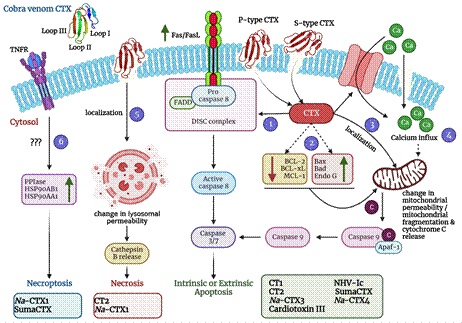Ministry of Science & Technology
Current insight on the mechanisms of Cobra venom cytotoxins can help anti-venom therapy
Posted On:
02 FEB 2023 3:17PM by PIB Delhi
Scientists have traced the mechanisms of the toxic action of cobra venom, paving a path towards developing strategies for application of antivenom or small molecule inhibitors, which can help mitigate the local toxic effects of cobra venom retained at the bite site.
Cobras (genus Naja) are widely distributed over Asia and Africa, and cobra bites are responsible for large mortality and morbidity on these continents, including the Indian sub-continent. Like other elapid venoms, cobra venoms are neurotoxic in nature. However, they also exhibit local cytotoxic effects at the envenomed site, and the extent of cytotoxicity may vary from species to species.
Proteomic studies from several other laboratories have demonstrated that cobra venoms are predominated by the non-enzymatic three-finger toxin family, constituting about 60-75% of the total venom. Cytotoxins (CTXs), an essential class of the non-enzymatic three-finger toxin family, are ubiquitously present in cobra venoms. These low-molecular-mass toxins, contributing to about 40 to 60% of the cobra venom proteome, play a significant role in cobra venom-induced toxicity, more prominently in dermonecrosis (local effects). Some CTXs are also responsible for depolarizing neurons and heart muscle membranes, thereby contributing to cardiac failures frequently observed in cobra-envenomed victims. Consequently, they are also known as cardiotoxins (CdTx). Interestingly, the proportion of cobra venom CTXs varies dramatically across different Naja species. Usually, venoms from African spitting cobras have a higher proportion of CTXs than the Asiatic cobra ones, indicating geographical variation in snake venom composition.
A recent study published in the journal Toxins led by Prof. Mukherjee, Director of the Institute of Advanced Study in Science and Technology (IASST), Guwahati, an autonomous institute of the Department of Science and Technology and his collaborators Prof. Yuri N. Utkin from the Shemyakin-Ovchinnikov Institute of Bioorganic Chemistry, Russian Academy of Sciences, Moscow, and Dr. Bhargab Kalita from Amrita Vishwa Vidyapeetham, Kochi, has comprehensively discussed the mechanisms of action of cobra venom CTXs and highlighted their significance in cobra venom-induced pathophysiology and toxicity. Furthermore, this collaborative review article shed light on the efficacy of commercial antivenoms in mitigating the toxic effects of this significant class of cobra toxins.
Prof. Mukherjee emphasized that being low-molecular-mass toxins, cobra venom CTXs induce low immune responses during the traditional production of antivenoms. Therefore, commercial antivenoms lack sufficient antibodies to neutralize these cobra venom toxins. Dr. Mukherjee added that due to this sub-optimal performance of commercial antivenoms against cobra venom CTXs, in-patient hospital management of local effects prevalent in cobra-envenomation is challenging and still a grave concern that requires immediate attention.
The authors believe that the recent advances in molecular biology and protein engineering can significantly facilitate the solution to this problem and aid in creating highly immunogenic toxins/toxin fragments for antivenom production. Moreover, they suggested that developing strategies for topical application of antivenom (small antibodies, e.g., VHH or nanobodies) or small molecule inhibitors may be a more effective alternative to mitigate the local toxic effects of cobra venom CTXs retained at the bite site.
Publication link: https://doi.org/10.3390/toxins14120839

Figure 1: A schematic diagram depicting diverse mechanisms of action of cobra venom CTXs that ultimately lead to cell death by apoptosis, necrosis, or necroptosis. These cell death mechanisms, in turn, potentiates the local effects of cytotoxins at the envenomed site.
*****
SNC / RR
(Release ID: 1895719)
Visitor Counter : 2100